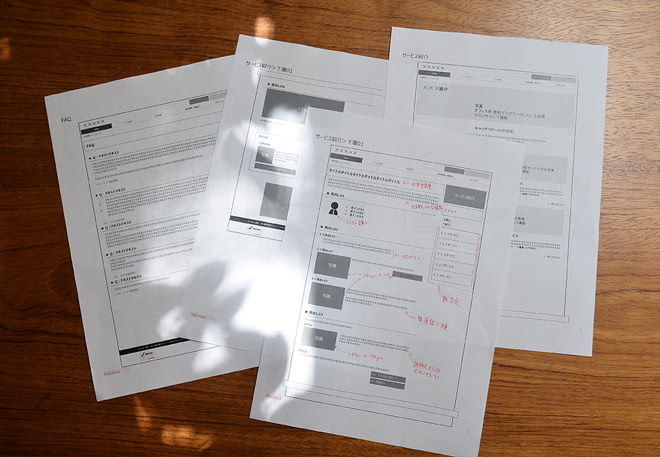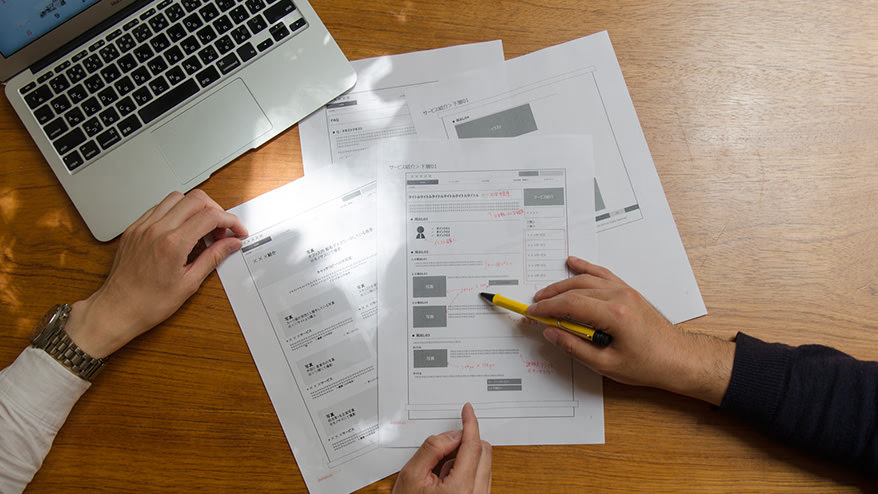こんにちは、ディレクターの大藪です。
もともとコーダーとしてWeb制作に携わっていた自分がディレクターに転身してから早や2年。当初は案件を無事に納品することで精一杯でしたが、さまざまなクライアントとの案件をとおして、これまでと違う視点から「Web制作において大切なこと」が見えてきました。
今回は、ディレクターとしての立場から、Web制作におけるクライアントとの関わり方のポイントについて、お伝えしたいと思います。
クライアントの目線を持つということ
コーダーからディレクターに転身し、制作時に「手を動かす側」から「手を動かさない側」になったことで、大きく変わったことがあります。
それは、クライアントと制作者をつなぐ立場になった、ということです。
制作者としての目線を踏まえて社内の担当者と共同作業することは言うまでもありませんが、それ以上に大切なのは、クライアントとしての目線を持って「クライアントと共同作業していく」という感覚なのだなと実感しています。
クライアントと共同作業するとはどういうことなのか、具体的な制作の流れに沿って、ご説明します。
1.「社内確認タイミング」をふまえたスケジュールを

制作の軸となるスケジュール。案件、クライアントの状況を考慮してしっかり決めていきます。
案件スタート時に作成するスケジュールですが、決める時には、「クライアント側の社内承認フロー」について特に考慮すべきだと思っています。
クライアント側の担当者だけで提案内容の確認から承認まで可能なのか、
上司の方もしくは社長の確認・承認も必要になるのか、
クライアントの状況によって、提案内容が決定するまでの期間が大きく変わってきます。
以前担当した案件で、海外にいらっしゃる社長の承認が必要ということで、デザインなどの提案内容が決定するまでに1週間以上かかったこともありました。
納期の関係で確認期間の調整をお願いすることもありますが、基本はクライアントの状況に合わせて制作を進めていきますので、クライアントの承認フローはしっかり把握しておくことが重要です。
スケジュールは、制作側の都合だけで決められるものではありません。
クライアントとの情報共有があって、はじめて「本当に守るべきスケジュール」ができる。それが案件を成功させる第一歩になるのだと思っています。
2. 原稿や写真、いっしょに作っていくつもりで
制作が進むと、サイトに掲載する写真や画像、原稿などの“制作素材”が必要になります。
写真について制作側で撮影を行うこともありますが、どんな内容で撮影するのか事前にクライアントに相談しつつ、撮影に向けて人や場所などを手配いただくことが必要になります。
また、イラストなどを作成する場合も、ラフ案や参考イメージを提案しながら、トーンやルールを決めて、クライアントの希望に沿ったものを実現していきます。
原稿についても細やかに確認しながら進めます。キャッチコピーからリード文、本文となる長いテキスト、リライト作業の有無まで様々ありますが、どんな内容にするのかクライアントにヒアリングしながら、場合によっては元になる文章をクライアント側に手配していただくこともあります。
これらの制作素材をクライアント側で用意いただく際に、私がいつも活用しているのがワイヤーフレームです。
クライアントが素材を作成しやすいように、各ページのどの部分に何が必要なのか一目でわかるようワイヤーフレーム上に記載しています。
ワイヤーフレームを活用することで、どのページの何が入稿済みで、何が未入稿なのかという状況を、クライアント側と確実に共有することができます。

写真、画像や原稿の詳細を落とし込んだワイヤーフレーム。素材収集の際に欠かせない資料。
このようにページの素材を集めていく際も、クライアントに単純に依頼するだけでなく、われわれ制作側がリードしながら「クライアントと一緒に決めていく」意識が大切だと思っています。
3. いよいよ本番公開、お互いの役割分担をしっかりと
制作の最終工程である本番公開についても、公開に向けて役割分担を確認して決定しておく必要があります。
例えば、
サーバーはどうするのか、公開作業は誰が行うのか、などしっかり事前確認することが必要です。
クライアントがサーバーを用意し、公開作業まで行うということもありますが、
要件を満たしている適切なサーバー環境の提案や、サーバー内を事前確認し、ファイルのアップロード先を指定するなど、制作側のフォローが必要です。
もちろん、制作側で公開作業を行う場合も、「これから作業を行います」「現在作業中です」「公開完了しました」など、逐一状況を報告しながら、クライアントと連携して進めることが大切です。
本番公開は、クライアントと制作側、お互いが一番緊張する瞬間です。
公開時こそクライアントの状況に合わせて、制作側が柔軟に動いていくことが重要だと思います。
まとめ
様々な案件においてWeb制作の工程自体が大きく変わることはほぼありませんが、決まった工程の中でもクライアントの状況によって制作側の対応を変える必要は多々あると感じています。
私がコーディングを始めた頃には気がつかなかった、Web制作に必要なこと。
それは、クライアントと情報共有をしっかりして、どう関わり案件を進めていくか考えることです。
案件を担当する度新たな気づきはまだまだ出てくると思いますが、今後もこういった気づきを蓄えて、クライアントも制作側も気持ちよく公開を迎えられるよう導いていける、そんなディレクターを目指していきたいと思います。

